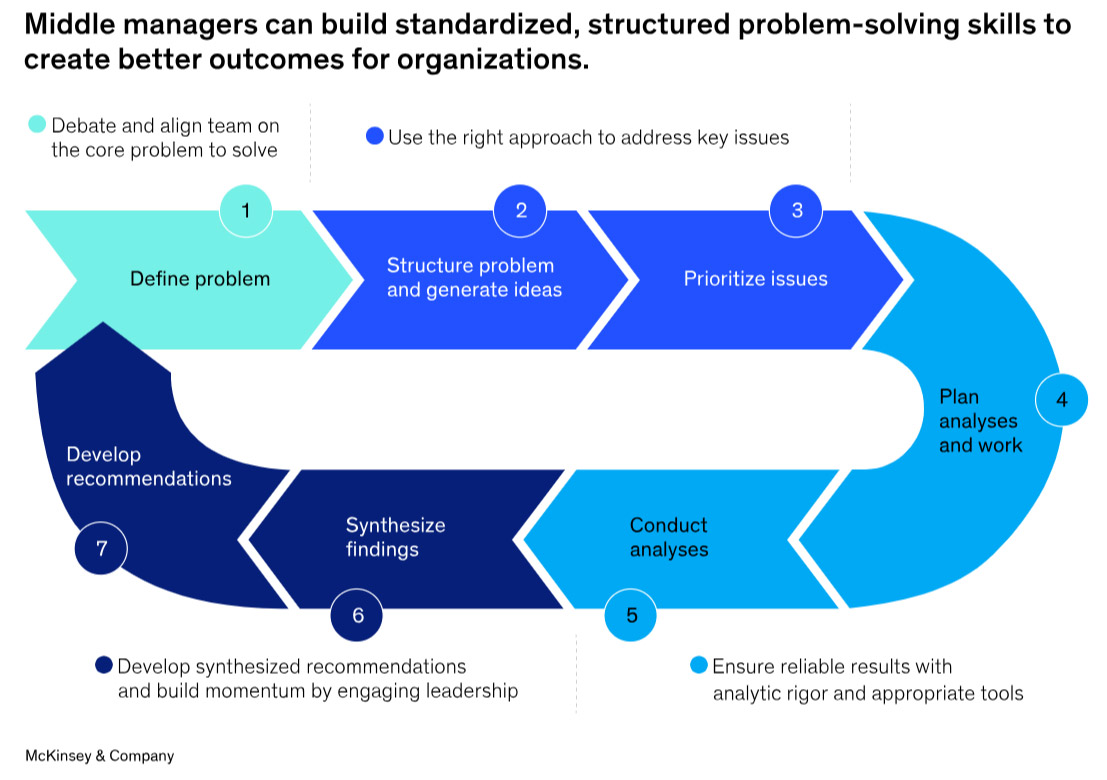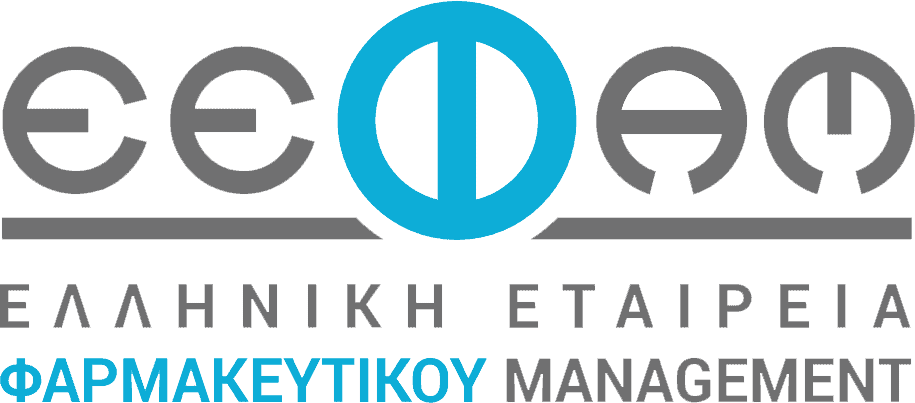Blog
Blog
Activating middle managers through capability building

Few groups are as maligned as middle managers—that vast middle tier of sales managers, program managers, account managers, branch managers, and more wedged between senior management and the front line. As we argue in our recently published book, Power to the Middle (Harvard Business Review Press, July 2023), middle managers who are equipped with the skills and support they need to succeed can reduce friction, accelerate action, and ensure that an organization achieves its vision.1
However, in many companies, middle managers have been left behind, consigned to act merely as paper pushers, bureaucrats, and rule enforcers. This means that when businesses flatten their organizational structures and look for ways to automate processes, middle managers tend to be the first groups targeted for layoffs and restructuring. Those who are left behind are often underinvested in or even ignored, left with lagging skill sets as the world changes around them. This became abundantly clear during the COVID-19 pandemic, when leaders pushing for greater operational speed found that their middle managers lacked necessary skills.2
As the pace of organizational change accelerates,3 C-suite leaders and other decision makers can empower middle managers by training them in the skills they need to succeed: strategic thinking, problem solving, effective communication, and coaching. In this article, we explore real-world examples of companies that have successfully built the capabilities of their middle managers. We also discuss common hurdles to implementing capability-building programs and how leaders can overcome these obstacles to activate the potential of their middle managers.
Unlocking the potential of middle managers with capability building
As the connective tissue between strategy and execution, middle managers have a unique ability to power organizations. Sandwiched between layers of the organization, middle managers can accelerate the execution of a company’s strategy by translating ideas between layers of hierarchy and solving problems with data. They are also critical people leaders, helping their direct reports grow, building connections across the organization, and attracting new talent. Middle managers can even be “talent multipliers,” increasing the effectiveness of their people with coaching and thereby cascading impact throughout the organization.
But too often, through no fault of their own, middle managers are unable to achieve their full potential. They are pulled in many directions and asked to do too much without having the skills to succeed. As a result, middle managers can be the most burned-out employees in an organization—but they are often the last to get a coach. When they do receive training, these programs are far too often monthly or annual “check the box” exercises.
Because they are accountable for decisions regarding middle managers, senior leaders need to prioritize capability building for this group and engage in purposeful coaching to support their development. A few skills stand out as being particularly useful to middle managers:
- designing and executing strategic plans (creating strategies that align, engage, and mobilize teams toward common goals)
- engaging in complex problem solving (defining the problem, structuring relevant components, and prioritizing issues for analysis)
- synthesizing ideas and communicating effectively (structuring communications in a top-down format, tailoring messages for the intended audience, and inspiring others to action)
- coaching direct reports to amplify their impact (developing and empowering people, leading with emotional intelligence, engaging people, and attracting and retaining top talent)
A wide variety of organizations illustrate what is possible when senior leaders take the time to reimagine the role of middle managers. Below, we explore how several companies have made great strides in empowering middle managers by building these targeted capabilities.
Designing and executing strategic plans
During a major transformation, a large North American bank identified a need to strengthen strategic thinking and related problem-solving approaches within its marketing organization. Marketing managers had not been empowered to make strategic decisions or expected to cultivate the strategic thinking or problem-solving skills that could make them peers to business unit leaders. By treating marketing managers as executors instead of thought partners, the company had missed an opportunity to integrate marketing expertise in high-level decisions and limited marketing team managers’ sightlines into the strategic objectives of business units.
To enhance the impact of its marketing managers, the bank implemented a capability-building program focused primarily on business strategy and problem solving. Over ten months, participants engaged in virtual and in-person workshops, digital coursework, peer group work, and mentoring and coaching. Managers learned how to better align programs with the overall business strategy, ensuring that their campaigns would reach the businesses’ intended audience most effectively. Most marketing managers (93 percent) highly recommended the program and were set up for success, leading more than 20 new initiatives to create additional value for the bank.
Engaging in complex problem solving
As the world of work continues to change, middle managers will confront increasingly complex problems.4 This makes problem solving an increasingly important area of expertise for middle managers. A global not-for-profit focused on public health recognized that many of its middle managers had challenges solving problems effectively. Leaders often dove into solutions without taking the time to properly assess the problem at hand. Because these managers came from a range of backgrounds and regions, they did not have a common skill set, process, or language for finding solutions, even though everyone had good intentions aligned with the organization’s mission.
As the world of work continues to change, middle managers will confront increasingly complex problems.
Senior leaders decided that middle managers would benefit from a standardized, structured process to smooth and speed problem solving across the organization. This involved breaking down the process into seven distinct actions across four key phases: debating and aligning the team on the core problem, using the right approach to address key issues, ensuring reliable results with analytic rigor and appropriate tools, and developing synthesized recommendations and building momentum by engaging leadership (exhibit). After engaging in deep capability building, participants reported a 51 percent increase in core problem-solving competencies. Moreover, participants were able to cascade lessons and behaviors throughout the broader company by teaching the core seven-step process to their direct reports, unifying company culture and accelerating problem solving across the entire organization.

Synthesizing ideas and communicating effectively
For any insight or solution to be effective, middle managers must also have strong communication skills.5 However, communication from middle managers often gets lost in translation, particularly when coordinating activities across the organization or cascading directives downward. As a result, team members might prioritize the wrong work actions, resulting in wasted time and unmet objectives. This has a corollary impact on culture and morale, because poor communication and wasted work can erode trust and confidence in middle managers. This was the case at a multinational insurance company, where the chief information officer of the IT group identified that middle managers in IT were having challenges communicating synthesized recommendations to advance their work at the required pace.
To help its IT managers build skills, this organization embarked on a two-phase journey, starting with building a core communication skill set and a common language among managers. After IT managers developed these skills, they focused on cascading their skills across their teams. The company found that the program improved communication skills across the IT organization, with 100 percent of colleagues reporting an improvement in their fellow managers. IT middle managers were able to convey well-structured, synthesized messages across diverse media (such as virtual meetings, in-person meetings, and email), modeling these skills so effectively that the organization has explored training other business units in communication capabilities.
Coaching direct reports to amplify their impact
In the most effective organizations, middle managers don’t just manage; they coach. By investing time in their team members without being overly directive, coaches multiply the impact of talent, foster personal growth, and maximize the overall contribution of the team. But too many middle managers suffer from a gap in coaching skills, simply ensuring individual compliance rather than actively coaching.
To create a coaching culture, a beverage retailer carried out a capability-building program to hone the team-management skills of managers. Participants learned a coaching tool kit that included critical people-leadership skills, which integrated directly with their day-to-day team-management practice. The program started with a set of 40 managers who subsequently served as ambassadors to roll out coaching skills to their top 300 people leaders. The ambassador structure not only enabled the organization to cascade skills but also empowered this subset of 40 managers to actively practice coaching by leading huddles with small groups. As a result, managers were transformed into dynamic coaches with a strong focus on the personal development of their direct reports, which led to improved employee engagement scores across the organization.
Hurdles to implementing capability-building programs
In all of the above examples, proactive skill-building investments by senior leadership empowered middle managers to develop themselves as strategic thought partners, problem-solving navigators, communicative connectors, and talent multipliers.6 However, designing effective programs to upskill middle managers is not easy. Even in the most well-intentioned organizations, senior leaders looking to build programs frequently encounter roadblocks, particularly in the following areas:
- Time. Many middle managers are very busy, making skill-building programs just another time-consuming task on their already overloaded plates. When facilitators present a large quantity of information all at once without reinforcing it, many learnings can be lost, particularly when focus is limited in the first place. Capability-building programs also may not undertake interventions at specific times when they matter more, such as during role transitions, wasting an opportunity to accelerate growth in new domains and duties.
- Scale. The sheer size of some middle-manager groups means that training every individual manager can be daunting. Frequently, the scale of the program may not be commensurate with the size of the group that needs to be trained. Companies may not take the time to consider which members of a group truly need to hear a given message, or they may rely on one-time interventions or programs that are too restricted in size to be effective.
- Curation of skills. Programs can fail to strike the right balance between teaching what is generally applicable and curating training to middle managers’ specific needs. As previously outlined, the following skills are pivotal for middle managers: executing strategy, solving complex problems, communicating effectively, and coaching direct reports. That said, given constraints on time and resources, organizations should prioritize and sequence capability building based on what their middle managers need most.
- Budget. Companies can struggle to build capabilities in a cost-effective way while still making an impact. They may not know how to structure programs to get the most out of their investments. In addition, budgets for upskilling middle managers can be particularly limited, putting high pressure on programs that are rolled out. However, organizations with strong managers realize 21 times greater TSR than those with weak managers.7 In other words, it is pivotal for organizations to prioritize skill building for this group even when budgets for middle managers are limited.
If these hurdles are not addressed early, they can reduce the effectiveness of a program or stop it before it even begins. Senior leaders would do well to pay attention to each of these concerns if they want to unlock the potential of their middle managers for the benefit of the organization.
How to build better programs and capabilities for middle managers
Four principles can help senior leaders implement capability-building programs that drive impact and accelerate the personal growth of middle managers. These principles are symbiotic in nature; for example, by integrating learning in the flow of work via supervisor-led coaching, cohort-based peer support groups, and digital learning, organizations can not only reinforce skills but also scale learning while being mindful of their bottom line.
1. Practice and reinforce skills in the flow of work
Capability-building programs don’t have to be time-intensive energy drains for already-busy middle managers. Instead, learning can be purposeful, bite-size, and integrated into the flow of work. When capabilities are practiced and built on the job, middle managers can immediately apply what they’ve learned and continue building their capabilities even after the seminar or webinar is over. With an ongoing focus on skills, senior leaders can also make data-driven point-in-time interventions, such as for brand-new middle managers who are stepping into a people-leader role for the first time. Furthermore, when senior leaders create space to be role models and coaches for their middle managers, they enhance learning and build an apprenticeship culture of intentional development across the organization.
2. Cascade skills across the broader organization
To address the problem of scale, programs can be designed to cascade skills throughout the organization. Combining a “train the trainer” approach with digital reinforcements allows a smaller group of direct participants to teach the skills they have learned to their peers and direct reports, which has the added benefit of reinforcing their own skill sets. This allows programs to reach more people and builds a sense of ownership and responsibility with minimal additional cost.
3. Prioritize skills that add value
Senior leaders should assess the needs of middle managers and choose targeted capabilities that can help managers do what’s necessary to achieve the business strategy. Leaders can consider whether to target one or two specific skills or conduct holistic skill transformations. Making these decisions requires clarifying which role middle managers will be expected to play and which critical competencies they will need to fulfill those roles. With these guiding principles established, leaders can identify skills gaps and design the learning journey to address them—for example, through design hackathons or by gathering insights from other programs.
4. Measure impact and ROI
Beyond making programs more effective, as we have described above, it is important to measure the bottom line and behavioral impact of a program to justify budgetary decisions. To effectively measure business impact and long-term ROI from a program, senior leaders must first identify the critical business outcomes that new capabilities are expected to generate. Senior leaders can then establish a baseline across these key measures before launching a capability-building journey.
For example, leaders can use “behavioral 360” assessments to track manager competency before and after a program through self, peer, leader, and direct-report feedback, or they can measure time to project completion to see how a program has improved organizational speed. Measurement can also help sustain behavior changes in the long term and help leaders identify future critical interventions for middle managers.
As the single most important determinant of employee outcomes ranging from performance to satisfaction, middle managers are central to organizational success. However, middle managers will fail if they are not equipped with the skills they need to unlock their performance. For middle managers to thrive in increasingly dynamic roles, senior leadership must invest in their training and development. And in a rapidly changing world, the time to activate the middle is now.
Πηγή: mckinsey.com







